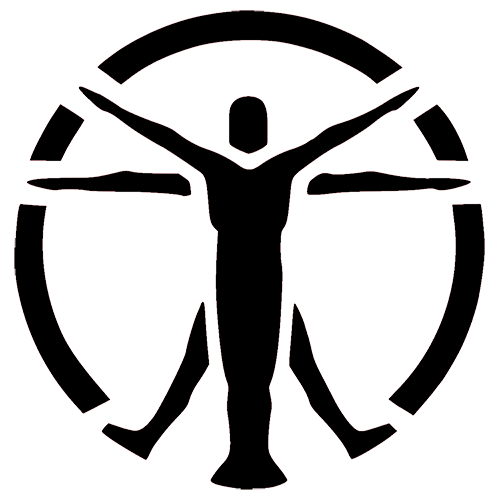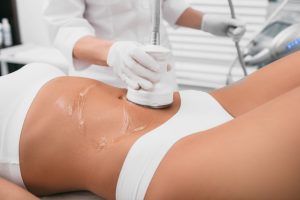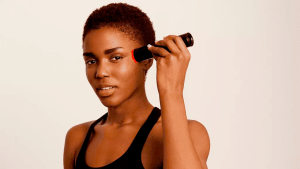Stretch marks can be an unsightly reminder of pregnancy, weight gain, or adolescent growth spurts. If you’re looking for a way to get rid of them, you may be considering laser stretch mark removal.
No matter what caused your stretch marks, laser stretch mark removal is an advanced procedure that can provide optimal results and help you get the clearer, smoother skin you dream of. This is a non-surgical approach to getting rid of stretch marks with well-tolerated, no-downtime treatments.
We will answer all your questions about the procedure, including how it works, scientific studies on its effectiveness, and before/after results from real patients. We’ll also give you tips for preparing for and recovering from laser stretch mark removal.
How does laser stretch mark removal work?
Stretch marks, also known as “striae” are the result of the skin being stretched too far, too quickly. It happens when you gain or lose weight fast, during puberty, pregnancy, bodybuilding, or steroid use. When this happens your skin can’t keep up with the rapid changes in size and it tears causing scar tissue to form.
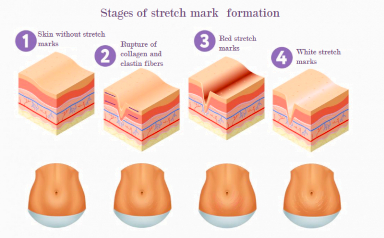
The most common areas for stretch marks are the lower abdomen, upper thighs, chest, and buttocks.
Laser removal of stretch marks works by concentrating light rays on the skin. There are two ways to do this.
- Ablative laser procedure
The first method is by removing thin layers of the skin with a laser beam. This promotes the growth of new smooth skin without stretch marks.
This method will suit people who have large stretch marks because it removes part of the skin at a time and can therefore treat deep scars. However, it can cause darkening or lightening of the treated areas (hypopigmentation or hyperpigmentation).
- Non-ablative laser procedure
The most common laser treatment is the non-ablative method, which uses a copper bromide and argon laser to reduce the stretch marks appearance. This process has been shown to improve skin texture and color by stimulating collagen production.
Non-ablative lasers can be used on any skin type and color as it is less aggressive than ablative lasers.
Both procedures can be done in conjunction with other skin treatments such as scar massage therapy, dermabrasion, and chemical peels.
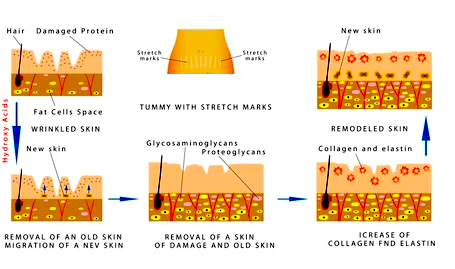
How effective is laser stretch mark removal? Based on scientific research
When it comes to laser stretch mark removal, you will find many reviews online. Some people claim that their stretch marks have not shown any drastic changes. On the other hand, many success stories seem to be trustworthy.
But what do medical studies say about the effectiveness of laser stretch mark removal?
In the study [1], 20 patients with red (9) or white (11) stretch marks (striae) received two 585 nm laser treatments (one session every 6 weeks). The total duration of the study was 12 weeks. As a result, the procedures had a beneficial effect on the reduction of red stretch marks. White stretch marks did not have obvious changes. The total amount of collagen was also increased, which contributes to greater tissue elasticity.
The following study [2] confirms the effectiveness of laser treatment for red stretch marks. 20 patients with immature striae (i.e. red) were treated with a 1064 nm laser. As a result, more than half of the patients (55%) noted the effectiveness of the treatment. Clinical results have also shown an increase in dermal collagen.
Another study [3] was involving 51 patients with stretch marks on the chest, thighs, and abdomen. Treatment parameters included two to four laser treatments spaced 4 to 6 weeks apart. Clinical assessments have shown an overall improvement of 51% to 75% for all patients (both red and white stretch marks) six months or longer after the last treatment. In all patients examined 18 and 24 months after treatment, there was no recurrence of striae. Typical side effects included , which resolved within a week. Also, observations showed a thickening of the dermis and an increase in collagen a month after the last procedure.

The next study [4] included 21 women with stretch marks. They underwent laser treatment monthly for 2 months. The results showed a significant reduction in stretch marks 6 months after the last visit. However, hyperpigmentation had been noted in patients with darker skin tone (phototype IV) that lasted for several months.
The development of stretch marks is a rare complication after breast augmentation. Lasers and lights have recently become a good therapeutic option.
The following study [5] is investigating the effectiveness of treatment for this condition. 47 patients underwent breast augmentation within 2 months; of these, 10 patients developed stretch marks. They were processed with a laser with a wavelength of 1550 nm. As a result, there was a high treatment satisfaction index (90%).
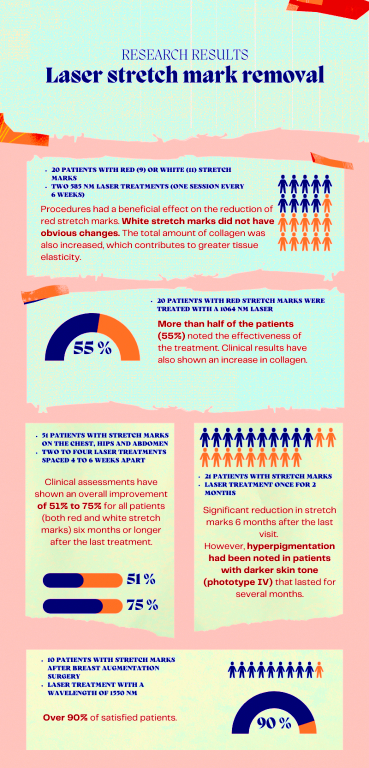
Before & after results of laser stretch mark removal
Based on the scientific studies presented above, we can conclude that laser therapy and light-based therapies, in general, have the potential to improve the appearance of stretch marks through a reduction in skin redness, uneven pigmentation, and length of existing lines.
Below are the results of patients before and after laser stretch mark removal.
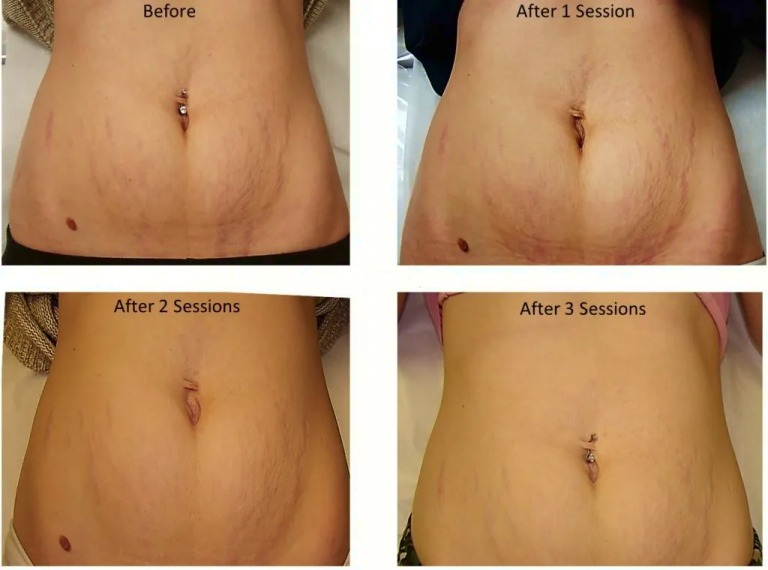

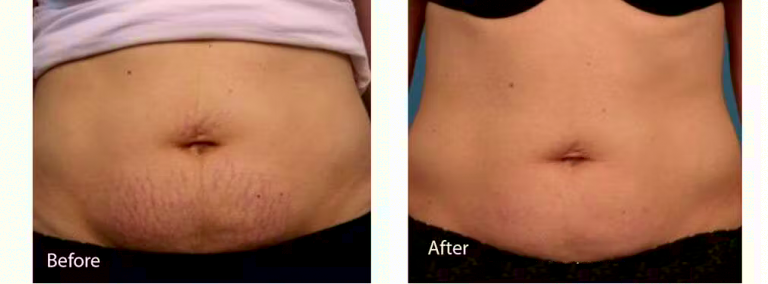
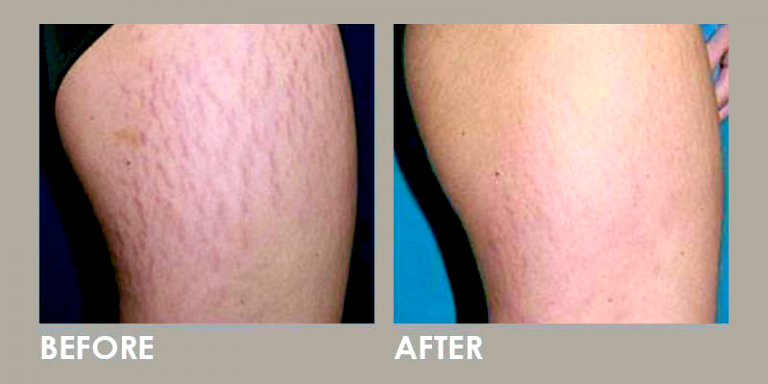
What to expect from laser stretch mark removal treatment?
Like any other laser treatment, this procedure involves a special tool that will act on the affected areas of the skin. The laser system will press against each area of the stretch marks to deliver a powerful combination of thermal heat and light wavelengths that penetrate deeper layers of the skin to kick-start the body’s natural regenerative properties.
For most patients, the treatment takes about 30 minutes, unless you treat several areas of the body at the same time.
This procedure is painless and does not harm the surrounding skin tissue.
How many laser treatments will you need?
For laser stretch mark removal, you will need to schedule multiple sessions for maximum results.
The number of sessions you will need depends on the severity of your stretch marks and the type of laser used. But a good average is 4 treatments with a couple of weeks between each treatment.
It should also be understood that you will not see the complete removal of stretch marks after laser therapy sessions. The American Society for Dermatological Surgery [6] estimates an improvement of 20-60% depending on the severity of the stretch marks.
What should you do before laser treatment?
Before laser treatment, the attending physician will review the patient’s medical history and conduct a physical examination.
Also, patients should avoid:
- Sunbathing, tanning beds, waxing, chemical peels, or collagen injections for two weeks before your procedure, because this can increase the risk of a burn;
- Perfumes, deodorants, or any potential irritants in the treatment area before and after the procedure;
- Aspirin, anti-inflammatory drugs, and herbal supplements due to an increased risk of bleeding.
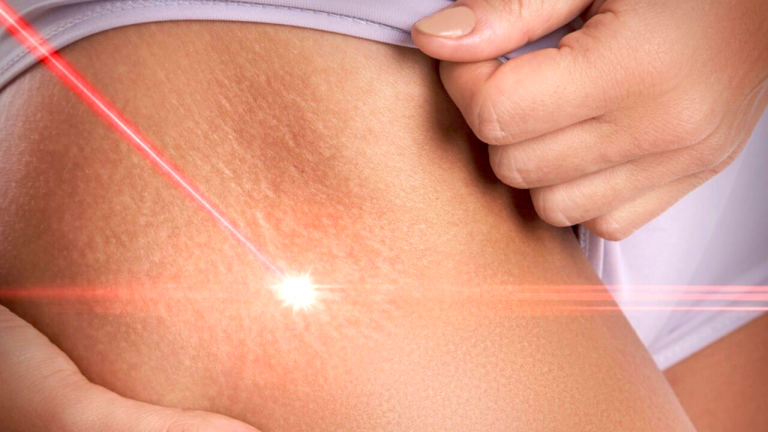
What should you do after laser treatment?
Your skin will be vulnerable after laser treatment, so it is very important to take steps to protect it:
- Stay out of the sun;
- Avoid tanning beds and self-tanning products;
- Wear SPF when you are outside. UV rays can pass through clothing, so it’s important to use sunscreen under clothing as well.
Pros and cons of laser stretch mark removal
Laser treatment is a common way to remove stretch marks from the body. But before you go under the laser beam, it is important to understand the pros and cons of this method.
Pros
- Shorter time to remove stretch marks. Laser stretch marks removal procedures last from 30 to 90 minutes. Compared to other stretch mark removal options such as ointments and lotions, it takes less time. Using creams may take several months of daily application to show results. While with laser removal, stretch marks begin to gradually disappear within 4 weeks after the first treatment.
- No surgery. Although laser treatment is sometimes referred to as laser surgery, it does not involve surgery. This means fewer complications and shorter downtime. Laser beams are concentrated on the skin affecting the top layer (epidermis) by stimulating the production of new collagen.
- Natural-looking stretch mark removal. Laser technology is designed to target the pigment in the skin that gives it its color. Once this pigment is gone, less noticeable stretch marks are visible. This means there may be no visible scars after treatment, unlike with other methods such as injections.
Cons
- Laser treatment is expensive. Laser treatment is expensive compared to other treatment options such as creams and lotions. You may need multiple treatments for the best results. Most patients use approximately 5-6 courses of treatment. Each procedure can cost you an average of $400 to $1,500.
- Side effects. Some side effects include bruising, swelling, and redness of the treated area. These side effects usually go away on their own, but if you notice any pain or discomfort, you should let your doctor know.
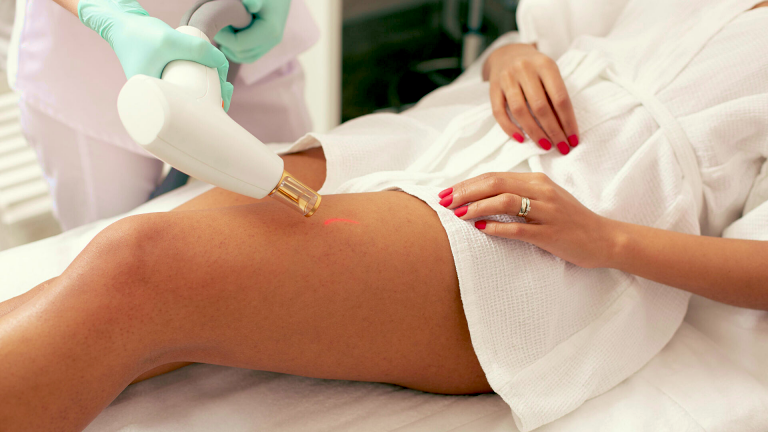
Having considered the pros and cons of laser stretch mark removal, we can conclude that it is an effective non-invasive treatment method. The procedure takes a little time, however, it is relatively expensive and may have some side effects.
Side effects of laser stretch mark removal
Patients may not notice any significant changes for several weeks after a session. However, the following side effects are possible:
- The treated area may be pink or red for four to eight hours after treatment.
- Slight tingling, similar to a mild sunburn, in the treated area. This feeling usually goes away within four to six hours. Cool compresses or wet wipes can be applied to reduce the sensation.
- Slight swelling in the treatment area, which usually resolves within a few days.
- Hyperpigmentation (darkening of the skin) in some patients. This effect is temporary and fades on its own with time, usually within one to three months after treatment.
Can stretch marks be prevented in the future?
Striae or stretch marks are a widespread problem for women, especially during pregnancy when the skin is stretched in multiple places at once.
Roughly 90% of pregnant women get them and many even lose some or all pigmentation on their abdomen after delivery.
Stretch marks can be prevented by doing the following:
🧴 Basic skincare
You should always use a moisturizer and protect yourself from the sun. This is more of a long-term solution since you’ll be doing this your whole life if you want to prevent them from forming.

🥑 Healthy diet and exercise
Eating a balanced diet with lots of fresh fruit and vegetables will give your skin the vitamins needed to stay healthy. Also, exercise is extremely important for general health. But in addition to that, building muscle mass also helps tighten up your skin.
☀ Avoiding exposure to ultraviolet rays and direct sunlight when possible
Sunburns can also be a cause of stretch marks since they generate free radicals which destroy the collagen fiber on the surface of your skin. You should always wear sunscreen and after an intense session of tanning, you should moisturize your skin as soon as possible.
Summary
Stretch marks, or striae, are cosmetic defects of the skin in the form of narrow wavy stripes. They appear on the chest, thighs, buttocks — in those places where the skin is stretched the most. Stretch marks do not pose any health hazard but can be disturbing with an unaesthetic appearance. The most effective method in the fight against stretch marks at the moment is considered laser removal.
Laser stretch mark removal is a non-invasive method that allows you to reduce the color and depth of stretch marks, minimize their visibility by creating new fibers in the skin.
Its effects are excellent and side effects are minimal. And sufficient hydration and massage after laser procedures will help maintain skin elasticity and be less prone to the formation of stretch marks.
FAQ
🤔 Is laser stretch mark removal painful?
The laser only targets the pigment of the stretch mark so it is not painful. However, if you have very sensitive skin or are severely scarred, you may experience some discomfort (such as skin tingling or scratching).
🔍 How many laser stretch mark removal treatments will I need?
Laser stretch mark removal works well in a series of 3-4 treatments spaced a month apart. However, the severity of the stretch mark has a significant impact as well.
⏳ How long does the laser stretch mark removal take?
Depending on the size of your stretch marks, it can take between 30 minutes to 1 hour for each treated area. For large areas of stretch mark scarring, you may need to schedule two or more sessions at one time.
🗓 How soon will I see the results after the laser stretch mark removal?
Everybody is different but most patients notice significant improvement after just a few treatments. Generally, stretch marks start to fade progressively during the 4 weeks following treatment and continue to improve over the following 3-6 months.
📌 Are there any side effects of laser stretch mark removal?
The most frequent side effect is erythema (redness) that lasted an average of 5-7 days. Itching or hyperpigmentation is also possible.
Sources
- Gloria P. Jiménez, Francisco Flores, Brian Berman, Zeenat Gunja-Smith. Treatment of striae rubra and striae alba with the 585-nm pulsed-dye laser. – Dermatol Surg. 2003 Apr;29(4):362-5. DOI: 10.1046/j.1524-4725.2003.29086.x.
- Alberto Goldman, Flávia Rossato, Clarissa Prati. Stretch marks: treatment using the 1,064-nm Nd: YAG laser. – Dermatol Surg. 2008 May;34(5):686-91; discussion 691-2. DOI: 10.1111/j.1524-4725.2008.34129.x. Epub 2008 Mar 10.
- Francesca de Angelis, Larissa Kolesnikova, Franco Renato, Giuseppina Liguori. Fractional nonablative 1540-nm laser treatment of striae in Fitzpatrick skin types II to IV: clinical and histological results. – Aesthet Surg J. 2011 May;31(4):411-9. DOI: 10.1177/1090820X11402493.
- Rungsima Wanitphakdeedecha, Walailak Meeprathom, Woraphong Manuskiatti. A pilot study of treatment of striae with variable square pulse Erbium: YAG laser resurfacing. – J Cosmet Dermatol. 2017 Dec;16(4):466-470. DOI: 10.1111/jocd.12391. Epub 2017 Aug 9.
- Paulo Afonso Monteiro Pacheco Guimarães, Alessandra Haddad, Miguel Sabino Neto, Fabiana Claudino Lage, Lydia Masako Ferreira. Striae after breast augmentation: treatment using the nonablative fractionated 1550-nm erbium glass laser. – Plast Reconstr Surg. 2013 Mar;131(3):636-642. doi: 10.1097/PRS.0b013e31827c7010.
